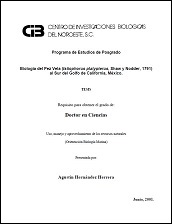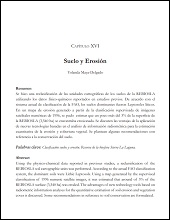Manejo sostenible del agua y fertilización en árboles adultos de naranjo (Citrus sinensis Osbeck) en la zona árida citrícola de B.C.S.
Abstract
"En el estado de Baja California Sur la agricultura desde hace tiempo es una actividad tradicional a pesar de presentar una serie de problemas. Las áreas de mayor importancia agrícola presentan problemas particulares tales como abatimiento constante del acuífero, intrusión salina y altos costos de extracción y de producción. Los suelos se caracterizan por ser de textura media la precipitación media anual es de 200 mm, irregularmente distribuidos a lo largo del año y la temperatura oscila entre los 40°C y los 0°C. Por lo tanto la mayoría de los cultivos tienen serios problemas para adaptarse a las condiciones agroclimáticas prevalecientes. Por lo anterior los requerimientos de agua y la fertilización, son interacciones complejas de un agrosistema que pueden generar conceptos basados en la respuesta puntual. Sin embargo la generación de la respuesta debe repetirse en la magnitud y proporción que la misma justificación requiera sobre la variable estudiada. Se llevaron a cabo investigaciones sobre el cultivo del naranjo desde el 2006, incluyendo la realización de experimentos en árboles adultos de naranjo con enfoque a la evapotranspiración, manejo del agua, fertilización y a la interacción de NPK en la respuesta productiva. Se obtuvieron resultados que se relacionan preliminarmente con recomendaciones a partir del diagnóstico nutrimental y sus efectos en el rendimiento. Para el estudio del manejo sostenible del agua, se relacionó la evapotranspiración y el suministro del riego para el aprovechamiento y manejo del recurso en la producción del naranjo. Se analizó el diagnóstico y el impacto del manejo de los recursos sobre la economía y desarrollo agropecuario regional. La demanda de agua promedio por árbol se determinó en 6.8 y 5.2 mm día-1, con métodos indirectos y directos respectivamente, con una diferencia de 30.8% entre ellos. Las desviaciones estándar fueron 0.05 y 0.03, El requerimiento de agua neto por ha, por día fue de 25 y 19 m3. Se encontró que la interacción NPK 8-8-0 g m-2 equivalente a 80-80-0 kg ha-1, con un rendimiento probable de 4.07 kg m-2 equivalente a 40.7 t ha-1, es resultado de usar la dosis en kg ha-1 en la función de respuesta obtenida como: Y = 35032 - 56.29N - 0.037N2 + 232P - 1.52P2 - 197.5K + 0.57K2 + 0.25NP + 0.44NK + 0.0003NPK. La eficiencia de utilización de agua fue de 5.06, y 4.03 g L-1 para interacciones media y alta 6-8-8 y 18-16-16 g m-2.El índice económico en 6-8-8 g m-2 NPK y 6-8-4 g m-2 NPK fueron de 5.19 y 5.43..." “In the Mexican State of Baja California Sur, agriculture has long been a traditional activity in spite of presenting a series of problems. The most important agricultural areas evidence particular problems such as groundwater depression and an evident saline intrusion into the aquifer, generating high costs of extraction and production. The soils are characterized as medium textured, with mean annual precipitation of 200 mm, unevenly distributed throughout the year and temperatures oscillating between 40 ° C and 0 ° C. Therefore most of the crops have serious problems adapting to the prevailing agro-climatic conditions. Because of this the requirements for water and fertilization, are complex interactions of a fallow system can generate concepts based on the timely response However, the generation of the response should be repeated on a broader scale, but at proportion that requires an adjustment on the study variable. Experiments were conducted out since 2006; on orange plots, with a study focus on orange evapotranspiration, fertilization and interaction of NPK in the productive stage. Preliminary results were obtained which are related to recommendations arising from nutrient diagnosis; in relation to sustainable water management, involved in the evapotranspiration process and irrigation supply for the use and management of soil and water in the production of orange, the diagnosis was analyzed on the basis of the impact of resource management on economy and regional agricultural development. The average water demand per cultivated area dedicated to Citrus was determined in 5.2 and 6.8 mm día-1, with direct and indirect methods respectively, with a difference of 30.8% between them. The standard deviations were 0.05 and 0.03, and the net water requirement per ha per day was 25 and 19 m3. It was found that the interaction NPK 8-8-0 g m-2 equivalent to 80-80-0 kg ha-1, with an estimated yield of 4.07 kg m-2 equivalent to 40.7 t ha-1, This is the result of using doses in kg ha-1 in the response function obtained as: Y = 35032 - 56.29N - 0.037N2 + 232P - 1.52P2 - 197.5K + 0.57K2 + 0.25NP + 0.44NK + 0.0003NPK. The water use efficiency was 5.06, and 4.03 g L-1 for intermediate and upper interactions 6- 8-8 and 18-16-16 g m-2.The economic index g m-2 6-8-8 and 6-8-4 NPK g m-2 were 5.19 and 5.43..."
Collections
Related items
Showing items related by title, author, creator and subject.
-
PROMOCIÓN DEL PERIFITON PARA EL CULTIVO DE CAMARÓN BLANCO: HACIA UNA ACUICULTURA ECOLÓGICA
DOMENICO VOLTOLINA LOBINA; JUAN MANUEL AUDELO NARANJO; MARIA DEL ROSARIO PACHECO MARGES -
Suelo y Erosión
YOLANDA LOURDES MAYA DELGADO


